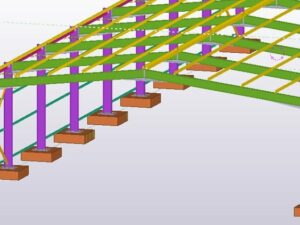Remote Sensing Introduction - AulaGEO
- Description
- Curriculum
- FAQ
- Reviews

Remote Sensing (RS) contains a set of remote capture techniques and information analysis that allows us to know the territory without being present. The abundance of Earth observation data allows us to address many urgent environmental, geographical and geological issues.
Students will have a solid understanding of the physical principles of Remote Sensing, including the concepts of electromagnetic radiation (EM), and will also explore in detail the interaction of EM radiation with the atmosphere, water, vegetation, minerals and other types. of land from a remote sensing perspective. We will review several fields where Remote Sensing can be used, including agriculture, geology, mining, hydrology, forestry, the environment and many more.
#AulaGEO This course guides you to learn and implement data analysis in Remote Sensing and improve your geospatial analysis skills.
Content:
-
Lecture 1:Introduction
-
Lecture 2:Definition and components
-
Lecture 3:Energy and electromagnetic spectrum
-
Lecture 4:Main characteristics of sensors optical
-
Lecture 5:Spectral signature
-
Lecture 6:Vegetation spectral signature
-
Lecture 7:Water Spectral Signature
-
Section 2:Characteristics of the sensors
-
Lecture 8:Spatial resolution
-
Lecture 9:Spectral resolution
-
Lecture 10:Temporary Resolution
-
Lecture 11:Radiometric resolution
-
Lecture 12:Relationships between resolutions
-
Section 3:Download satellite images
-
Lecture 13:Image Download
-
Lecture 14:Image Download
-
Lecture 15:Download of data models
-
Section 4:Remembering QGIS
-
Lecture 16:A brief review of QGIS
-
Lecture 17:Add-ons installation
-
Lecture 18:Base Maps in QGIS 3
-
Lecture 19:Introduction to SAGA GIS
-
Section 5:Pre-processing of satellite images (Improvements)
-
Lecture 20:Preprocessing
-
Lecture 21:Display and enhancement of images
-
Lecture 22:QGIS image cutting
-
Lecture 23:Multiple image cutting – PlugIn
-
Lecture 24:Color rendering
-
Lecture 25:Lecture 25: Pseudocolor Representation
-
Lecture 26:Spectral Band Composition
-
Section 6:Satellite Image Pre-Processing (Corrections)
-
Lecture 27:Corrections to satellite images
-
Lecture 28:Banding Correction
-
Lecture 29:Atmospheric correction algorithms
-
Lecture 30:Topographic correction algorithms
-
Lecture 31:Topographic Correction in QGIS
-
Lecture 32:Geometric correction
-
Lecture 33:Lecture 33: Rectificación de una imagen en QGIS
-
Section 7:Satellite Image Processing
-
Lecture 34:What can we extract from satellite images?
-
Lecture 35:Fusion of images (Pansharpening)
-
Lecture 36:QGIS image fusion
-
Lecture 37:Fusion of SAGA images (Brovey, IHS, CPA, spectral)
-
Lecture 38:Cloud cover mask
-
Lecture 39:Cloudless images Raster Calculator QGIS
-
Lecture 40:Cloudless Images – PlugIn
-
Section 8:Clasificación de imágenes de satélite
-
Lecture 41:Lecture 41: Clasificación de imágenes de satelite
-
Lecture 42:Lecture 42: Clasificaciones no supervisadas
-
Lecture 43:Interpret and optimize unsupervised classification
-
Lecture 44:Supervised Classification Configuration and Training Areas
-
Lecture 45:Supervised Classification – Spectral Signature Chart
-
Lecture 46:Supervised Classification – Previous Classification
-
Lecture 47:Supervised Classification – Optimizing the spectral signatures
-
Lecture 48:Supervised Classification – Minimum distance, Spectral Angle, Maximum Probable
-
Lecture 49:Supervised Classification – optimizing threshold algorithms
-
Lecture 50:Supervised Classification – Result with Mask
-
Lecture 51:Classification Accuracy
-
Lecture 52:Determination of classification accuracy
-
Lecture 53:Identification of ceilings with Segmentation
-
Section 9:Indices espectrales o radiométricos
-
Lecture 54:Spectral indexes
-
Lecture 55:Vegetation indices
-
Lecture 56:NDVI spectral index calculation
-
Lecture 57:EVI spectral index calculation
-
Lecture 58:Calculation of 14 vegetation indices in two steps
-
Section 10:Other tools for image processing and interpretation
-
Lecture 59:Principal component analysis
-
Lecture 60:Incremental algorithm, delimiting burned area
-
Lecture 61:Incremental algorithm, delimiting water-reservoir mirror
-
Lecture 62:Development of spectral profiles
-
41Lecture 41: Clasificación de imágenes de satelite
-
42Lecture 42: Clasificaciones no supervisadas-----------------
-
43Interpret and optimize unsupervised classification
-
44Supervised Classification Configuration and Training Areas
-
45Supervised Classification - Spectral Signature Chart
-
46Supervised Classification - Previous Classification
-
47Supervised Classification - Optimizing the spectral signatures
-
48Supervised Classification - Minimum distance, Spectral Angle, Maximum Probable
-
49Supervised Classification - optimizing threshold algorithms
-
50Supervised Classification - Result with Mask
-
51Classification Accuracy
-
52Determination of classification accuracy
-
53Identification of ceilings with Segmentation






Social Network